22 Vegan Food Sources of Iron (+ Recipes!)

Are you new to the vegan diet? Or curious if you’re getting enough iron on a vegan or plant-based diet? This detailed guide is for you! Let’s dive in.
I get a ton of questions about vegan iron sources so I wanted to put together a comprehensive list of vegan iron rich foods as well as a bunch of easy and tasty plant-based recipes using vegan foods high in iron. In this post, I’ll also answer the most common questions about iron and anemia on a vegan diet. If you’ve got questions about iron, this post has the answers!
As a plant-based dietitian, I spend a lot of time helping folks how to transition to a more plant-based diet, whether they’re looking for a tips on a vegan diet for beginners, a list of high fiber foods to support gut health or vegan sources of omega 3. I wrote Eat More Plants Cookbook to help folks learn more about a plant-based approach to anti-inflammatory nutrition and Good For Your Gut Cookbook to share my plant-based approach to gut health.
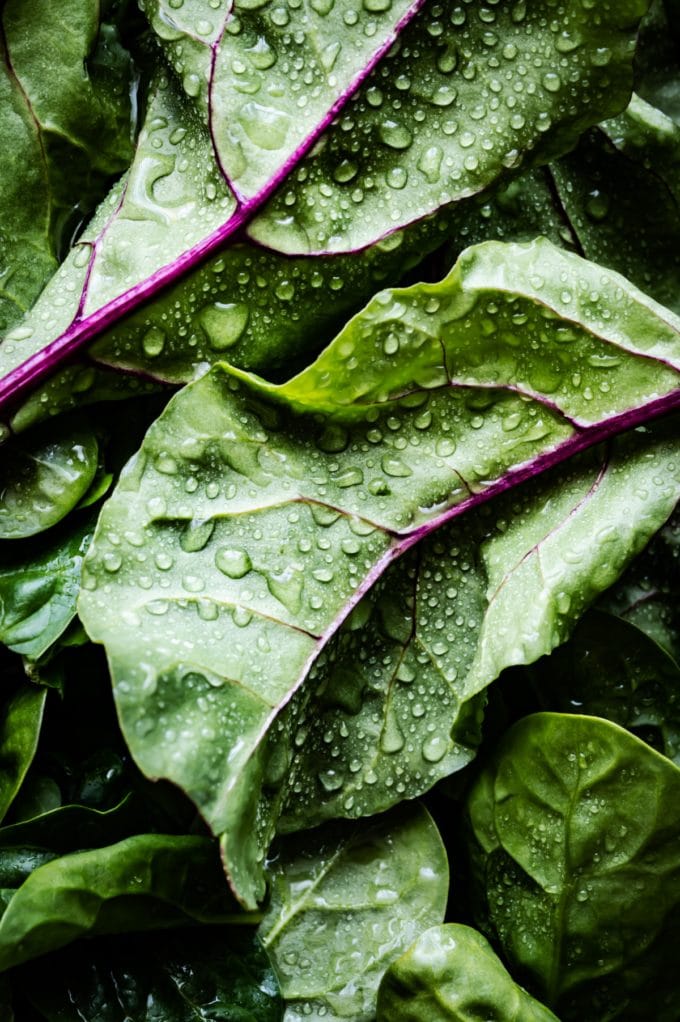
I know that there is a lot of confusion about iron on a plant-based diet so I wanted to arm you with as much information as I could! I’ve packed information on vegan iron sources, iron absorption and even recipes with vegan iron-rich foods in this post, so this handy table of contents will help you jump to the info you need most.
- How much iron do I need daily?
- What are the best iron rich foods for vegans?
- Are vegans at risk for anemia?
- How can I increase iron absorption from plant foods?
- What vitamins should vegans take?
- What should I know about transitioning to a vegan diet?
- 10 yummy recipes using vegan iron sources
All your questions about iron on a plant-based diet, answered!
1. How much iron do I need daily?
The RDA for iron is 8mg daily for non-menstruating adults, and 18mg daily for menstruating adults. In pregnancy, adults need 27mg daily.
Plant-based iron is of a type called non-heme, which typically has lower bioavailability than animal-sourced heme iron. If you are on a vegetarian or vegan diet, the official recommendation is that you consume 1.8 times more iron due to lower bioavailability of the non-heme iron, which would up the recommendation to 14.5mg for non-menstruating adults and 32.5mg for menstruating adults.
However, in practice, I find this number to be a bit unrealistic and based on theoretical risks that don’t always seem to pan out in the evidence. I encourage folks to opt for the standard RDA unless low iron status or anemia becomes an issue. Check the anemia section for deeper dive into the research on anemia and iron status in vegetarians and vegans.
2. What are the best iron rich foods for vegans?
Plants are pretty incredible: they offer almost all of the nutrition you could ever need from omega 3 fatty acids to calcium, zinc to protein. In fact, the only thing that plants lack is vitamin B12…and contrary to popular belief, there are a lot of plant foods that are high in iron! I think the biggest thing to remember is that often (but not always) iron follows protein in foods. So if you craft your meals using the plate method – make your plate 1/2 fruits and vegetables, 1/4 whole grains, 1/4 protein – you’ll probably but at least one iron-rich food on your plate. Which plant foods have the most iron? I’ve got 22 vegan iron sources right here
- Tofu 2.4mg per 150g serving
- Tempeh 4mg per 150g serving
- Edamame 2.4mg per half cup cooked
- Lentils 3.5mg per half cup cooked
- Chickpeas 2.5mg per half cup cooked
- Kidney Beans 2mg per half cup cooked
- Hemp Hearts 2.3mg per 2 tablespoons
- Pumpkin Seeds 3mg per quarter cup kernels
- Ground flaxseed 1mg per 2 tablespoons
- Almonds 1.3mg per quarter cup
- Cashews 2.2mg per quarter cup
- Dried Golden Berries 1mg per 3 tablespoons
- Dried Figs 0.5mg per 4 figs
- Tahini 2.7mg per 2 tablespoons
- Blackstrap Molasses 3.5mg per 1 tablespoon
- Tomato Paste 0.5mg per 1 tablespoon
- Cooked spinach 3.5mg per half cup
- Kale 0.5mg per half cup cooked
- Chard 2mg per half cup cooked
- Hearts of Palm 4.8mg per cup (canned)
- Spelt kernels 1.7mg per half cup cooked
- Oats 1.75mg per cup cooked (large flake)
- Quinoa 1.5 mg per half cup cooked
- Millet 0.5mg per half cup cooked
All iron estimates taken from the Canadian Nutrient Data File, except for golden berries where data was taken from manufacturer’s website (Navitas)
3. Are vegans at risk for anemia?
Vegetarians and vegans are thought to be at higher risk for anemia because they don’t consume heme iron and may consume less iron overall…but what does the current research say?
One 2018 review of the iron status of vegetarians and vegans found that vegetarians and vegans typically had lower mean ferritin or hemoglobin values than omnivores as well as a higher percentage of anemia vegetarian females. However, this review also found that actual deficiency rates were quite variable among studies. Specifically for vegans, in one trial, anemia rates were comparable to non-vegetarians. Most of the trials included in this review were also quite small.
In a 2019 study looking at blood markers in British vegetarians, which used data points from almost 500,000 people (of which 8308 were vegetarian or vegan) there was a slightly higher risk of anemia versus non-vegetarians but again, actual iron intake was not reported.
We need to consider how much iron people are eating while vegan. Is anemia a risk if you’re meeting your iron requirement, or only if you’re not eating enough?
A recent study looking at the nutrient status vegetarian women in Germany found that iron intake was not only adequate but higher than omnivores although the data fell short of statistical significance and both groups (veg + omni) reported iron supplementation. One small Finnish trial found that vegans consumed more iron than non-vegetarians, had lower ferritin status but not increased rates of anemia. In another small trial looking at runners, who arguably may be more health conscious than sedentary folks, iron status was similar among all women (veg + omni) and full iron-deficiency anemia was not found in any of the subjects.
In my opinion, the take home message here is that anemia is a risk for anyone with higher blood losses or blood volumes (menstruating adults, pregnancy, gastrointestinal disease) and anyone who doesn’t include enough iron rich foods in their diets (omnivore OR vegan).
In my practice, I have seen just as many omnivores with anemia as I have vegetarians + vegans. This certainly not a comprehensive review of the literature (feel free to link peer-reviewed research you think I should see, in the comments!) but based on what I have seen in the research so far, I feel that a vegan diet that includes vegan iron sources at every meal will minimize your risk of anemia so eat well and carry on!
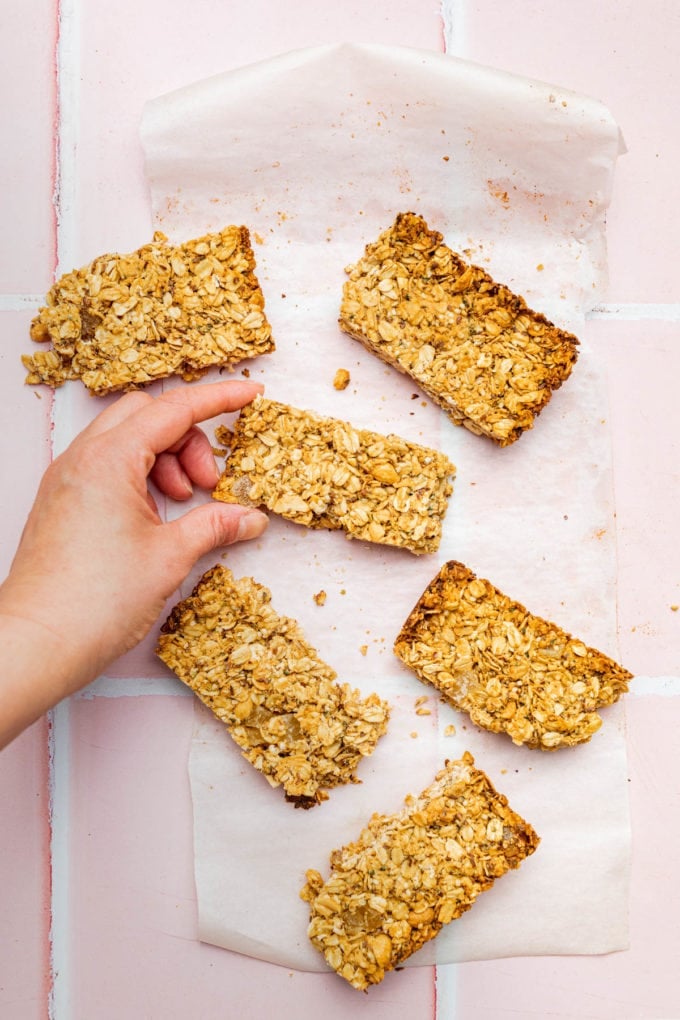
4. How can I increase iron absorption from plant foods?
There are a couple of reasons why vegan iron sources are less bioavailable than animal-source iron: including phytochemical binding and the form of iron (ferric versus ferrous). Naturally occurring phytochemicals in plant foods – oxalates, phytates and polyphenols – bind minerals making them less available for absorption. The also carry their own health benefits so don’t start freaking out about ‘anti-nutrients’! Here are a few ways to get even more iron from your plants:
- Soaking, fermenting, sprouting and water-based cooking methods minimize this binding. So soaking beans for 24 hours and then cooking them in fresh water minimizes phytates in legumes and improves your mineral absorption. Eating sprouted grain breads is another winner for iron intake.
- In addition, cooking greens (boiling/steaming) not only reduces phytate and oxalate binding but it concentrates the greens so the iron is higher. Think about how a whole bunch of spinach wilts down to a tiny cup!
- Eating vitamin C rich foods like red bell peppers, berries, oranges and broccoli helps to reduce plant-based iron into a more absorbable state. If your iron is low, know that tannins in coffee and tea – as well as large doses of calcium – can also hinder iron absorption so consider drinking them between meal times.
- If you’re a big coffee or tea drinker – and you have anemia – consider separating your meals and your coffee as it can decrease iron absorption. If your iron levels are fine, don’t worry about this!
5. What vitamins should vegans take?
There are many nutrients of importance on a plant-based diet, such as calcium, iron, zinc, omega 3 fatty acids and fiber. However, there are only two vitamins I think all vegans should take daily, vitamin B12 and vitamin D3. B12 is only found naturally in animal source foods, although it is fortified in many vegan-friendly foods such as plant-based milk alternatives and nutritional yeast. Adults need 2.4mcg daily, which is easy to get from an inexpensive supplement.
Vitamin D3 is necessary for ALL eaters, from birth, because our food supply is quite low in vitamin D. I recommend 1000IU in the brightest six months of the year (May – October for us in Canada) and 2000IU in the darkest six months of the year (November – April) as a safe and general recommendation. The best way to know how much vitamin D you should take is to have your doctor test your vitamin D levels so they can customize a dose based on your current vitamin D status and health profile.
All other supplements should be customized to your needs by your healthcare professional and I don’t recommend supplementing with single nutrient iron (as opposed to a multivitamin that contains iron) unless your doctor prescribes it. Too much iron isn’t a good thing either!
6. What should I know about transitioning to a vegan diet?
If you’re ready to transition to a vegan diet, that’s fantastic! I’ve got a comprehensive post on all the steps you need to take when transitioning to a vegan diet that will help with that.
10 yummy recipes using vegan iron sources
5 Minute No Cook Vegan Cashew Alfredo Sauce
20 Minute Vegan White Bean Sandwich with Kale
Crispy Baked Tofu Paneer with Mint Chutney
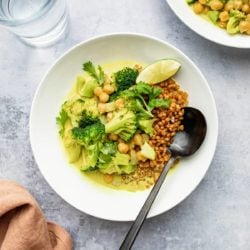
Easy Chickpea Coconut Milk Curry with Broccoli
15-Minute Vegan Apple Pie Oatmeal
Swiss Chard and White Bean Casserole
Green Goddess Spring Salad with Almond Ricotta
Vegan Lentil Shepherd’s Pie
5 Minute Blueberry Spinach Smoothie (high iron)

Iron Rich Recipes: Super Seed Butter
Ingredients
- 1 ½ cups raw pumpkin seeds (pepitas)
- ½ cup hemp hearts, (learn about the benefits of hemp hearts!)
- ½ cup raw sunflower seeds
- 2 tablespoons avocado oil, or pumpkin seed oil
- 1 to 2 tablespoons cane sugar, or maple syrup, see note, optional
- 2 teaspoons freshly grated ginger, or 1/2 tsp (2 mL) ground ginger
- ½ teaspoon ground cinnamon
- ¼ teaspoon salt
Equipment
- Food Processor
Instructions
- Place the pumpkin seeds, hemp seeds and sunflower seeds in a food processor and process them until they turn into a nice crumb.
- Next, with the motor running, drizzle in the oil to help get the butter process going. At this stage, the seeds will start to look like a dry dough and require lots of scraping.
- Keep going, scraping as necessary, and slowly it will form a paste that seems close to ready by 15 minutes. However, it's not quite creamy. What you're waiting for is the machine and the butter to start really heating up and the oils of the seeds to release. Some will toast the seeds in the oven first to get the oils releasing…but here I'm relying on the motor of the food processor to do my bidding.
- At about 20-25 minutes, it will look like a thick, glossy butter and then it is ready. When ready, add the salt and cinnamon and give it another whir to combine. Now, you've got a decision about sweeteners.
- If you add liquid sweeteners to a butter, you run the risk of it seizing and turning into a dough. So the safest bet is to add sugar and dried ginger and whir again.
- However, if you like living dangerously…which I do…then turn off the machine and add a bit of maple syrup and fresh ginger by hand. Now, it's ready to transfer into a glass jar and store in the fridge for up to a month. Or, eat it all on freshly toasted bread with a few of your closest friends and call it brunch.

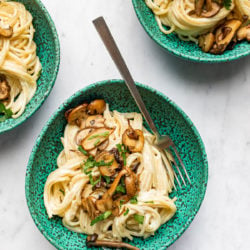

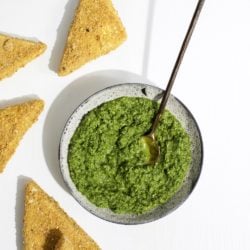
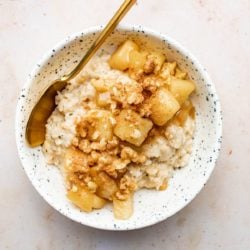
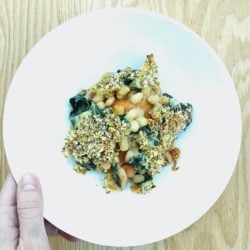






36 Comments on “22 Vegan Food Sources of Iron (+ Recipes!)”
Great info. as always, Desiree! Very comprehensive, informative, and highly appreciated! This will be a great reference to refer to!
Blessings and great health to all,
Jordanna
I’m so glad it was helpful to you Jordanna!
Such an incredible article… as usual! Thank you for the link to my hummus my friend.
Tori
You’re so welcome Tori… Thank you for your awesome recipes 🙂
Curious… the nut butter recipe at the end… why do the nuts need to be raw? Toasted/roasted has so much more flavour! Does heating them diminish the nutrients?
Hi Meghan,
Great question! I always recommend buying raw nuts and seeds for nutritional quality – and in this recipe, I left them raw because some folks like a raw recipe and there is a sweetness to raw butter that is nice too. But I totally agree with you, roasting the pumpkin and sunflower seeds (not the hemp because of omega 3!) will produce even more of a rich flavour – and save some processing time – so absolutely go for it if you like!
Thank you!
Great information, super interesting that veggies need 1.8x the recommended daily intake!
It’s something I’ve always been a bit suspicious of as in practice, it doesn’t seem to pan out…but that is the official recommendation!
Thank you for listing 22 vegan iron sources – that is so helpful and informative!
I usually sauté my greens in avo/olive oil is this a good way use them for maximum iron absorption or should I be boiling or steaming?
Also my regular blood test didn’t show I was low iron. I went to see a naturopath because I just wasn’t feeling right and she discovered I was extremely low in Iron and Vit D. Feeling so much better now
So glad you found what was going on for you! Sauteeing is great too 🙂
Thanks for the great blog post. My iron is always low so I’m often on the lookout for high iron recipes and easy ways to sneak iron into my diet. I’m definitely going to give the seed butter a go!
Hope you love it, Katie!
Great article. This is a vitamin I struggle getting in. I didn’t realize hearts of palm had so much iron. I need to google what hearts of palm even is. Do you have any yummy recipes for it?
Hi Emma!
Hearts of palm can be stirfried, shredded or slices into rounds. You can absolutely use them raw in salads…but they make a really fun plant-based meat substitute (think crab cakes etc) and maybe just maybe, I have a cool recipe coming next year (ahem) but alas not yet on the blog!
This is so helpful, Desiree! My teenage daughter is struggling to meet her iron needs so adding some of these tips & recipes are needed.
At what age do you recommend increasing the dosage of vitamin D to 2000IU in the winter months?
Thirteen!
Thank you for the clarification on iron recommendations between menstruating and non-menstruating people. Usually these recommendations are described as being for “women or men” but I’m a non-menstruating woman. This clears it up!
Right? It’s so important for us to get clear on what creates the recommendation. And here, it is clearly menstruation…not just whether you have a uterus or not 🙂
Such great information for vegans and non-vegans alike. Thank you!
Thank you for taking the time to leave a note, Marcia!
These recipes all look delicious and I love that you’ve cited the research because I always feel like I have to “defend” my diet to others so I like being informed!
It’s so true!! And luckily, we have more than enough research to show that plant-based eating is the way to go.
After reading this post and the one on zinc, I get now why I feel so good when I incorporate the “daily three: greens, beans & seeds” into my diet. As someone who has often had low iron, even when I was eating more meat, this combo really checks all the boxes in terms of essential minerals! As always, thanks Desiree for sharing your knowledge!
Hi Sarah! Absolutely – I chose my daily 3 based on their nutrient density, and minerals were a huge part of that.
Very informative and interesting! I loved the seeds butter recipe as I like making my own butters. Good info on the vegan sources of iron! Thank you for sharing your knowledge for the benefit of others.. power to you
Thank you Stutee! SO glad it was helpful
Thanks for the info. I always learn something when I read your posts.
So glad it was helpful, Amanda!
Lots of great ideas, thanks!
For adding vitamin C for absorption, would adding a squeeze of lemon to sauteed greens be enough?
The seed spread looks like a fun idea, is the ginger a necessary flavour? I think I’d like it but I would like my picky 5 yr old to try it too and I feel like it would be too strong for them.
Hi Joey!
Not quite enough, as lemons are surprisingly low in vitamin C! A splash of OJ is better. And you can absolutely leave out the ginger in the seed butter!
Thank you for the recipes! I’m trying to find new ingredients for lunch ideas and incorporate a little more plant based (and that white bean and cripsy kale sandwich sounds delicious!)
Glad to hear they are iron rich resources too (good for runners!). I just got your book Good For Your Gut from my local library and I am already thrilled at the in depth descriptions of the digestive system (like Intrinstic factor!). I am really looking forward to the Soothe section too. Thank you for all the great information!
Hi Sara,
Oh let me know what you think about that sandwich!! So glad GFYG is interesting so far. I LOVE getting nerdy about this stuff 🙂
Hello Desiree! I really appreciate all the information you’ve provided. I just have one question. I often have low levels of “iron” even when taking supplements. Since I’m now being more mindful of the foods I eat, I’m curious about whether I should pour away the cooking water after cooking foods with lots of oxalates, like spinach. Does this make a difference, or is it not really important? Thanks in advance!
Hi Bruna,
Iron can be tricky! Our bodies regulate their iron absorption, so simply taking a lot doesn’t guarantee your body will absorb it. In terms of food, oxalate will definitely leach into the cooking water so if you’re steaming or boiling, absolutely pour it off but if sautéing with other ingredients, don’t worry. Instead, maybe talk to a dietitian/doctor to see if there are any other factors inhibiting absorption, such as calcium or fibre supplements at the same time as your iron.
Good luck,
Desiree